The primary purpose of wiring is to make a bonsai tree precisely into a desired shape, which takes several weeks to several months to set.
Purpose of Bonsai Wiring
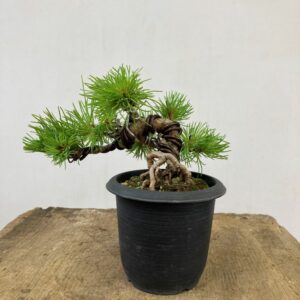
Wiring Japanese white pine
Wiring is unique and a fundamental technique in the art of bonsai that serves a vital purpose in shaping trees as bonsai.
The primary objective of wiring is to guide and manipulate the growth of branches and trunks to create a desired shape to perfection. The secondary objective of wiring, and auxiliary to the primary objective, is to keep the tree size small.
Create a desired shape
The primary purpose of wiring is to make a bonsai tree precisely into a desired shape. Wiring provides immediate and effective control over the placement and orientation of branches and trunks, enabling you to achieve a specific design vision for your bonsai tree.
After you’ve created a desired shape, your bonsai tree keeps growing. The shape will change as the direction and angle of the branches and trunk grow. The tree should be wired to restore a tree shape or transform it into another desired shape.
Without wiring, it may be very difficult, if not impossible, to style a tree as you like.
If you are wondering if bonsai can be created without wiring, the following post may help you.
Keep the tree size small
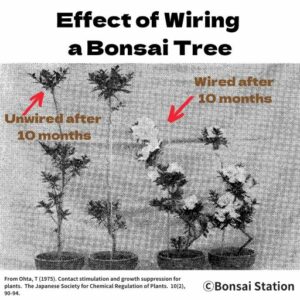
Effect of wiring a bonsai tree
Another purpose of wiring is to keep the tree size small.
When a tree is stressed, it makes a plant hormone called ethylene that induces the aging of trees as one of its functions. Wiring stress can inhibit a tree from continuously growing upwards and promote fine branches to develop and the trunk to thicken.
Wiring also has the effect of inducing flowering (and fruiting) earlier.
Prevent pests and diseases
This is not the “purpose” of wiring per se but arranging the branches by wiring in appropriate positions improves lighting and ventilation inside the foliage, which makes trees less susceptible to diseases and pests.
Sufficient light exposure promotes photosynthesis, leading to healthier foliage and overall tree vigor. Adequate ventilation inside the foliage reduces the likelihood of fungal diseases and creates an unfavorable environment for pests to thrive.
Effects of Bonsai Wiring
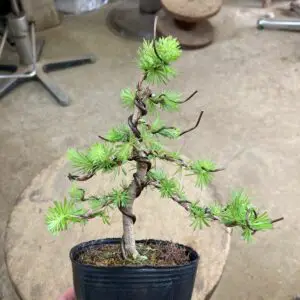
Bonsai wiring
Through wiring, you can manipulate the placement and orientation of branches to achieve balance within the tree composition. Generally, it takes several weeks to several months for the wire to set and the branches to retain their desired shape. These are, however, rough estimates and the actual time can vary on the individual trees.
Here are some factors that can influence the setting time of the bonsai wire.
Tree species
Different tree species have different growth rates and flexibility. Some species such as deciduous trees respond faster to wiring and may set in a shorter time, while others like coniferous trees may take longer.
Deciduous trees and flowering/fruiting trees grow quickly and so their branches tend to thicken faster. For these trees, wiring may need to be reapplied in about a month in some cases.
On the other hand, coniferous trees are slow-growing and wiring may be left on the trees for as long as a whole year.
Branch/trunk thickness
Thicker and older branches require more time to set because they are less flexible and need additional time to hold the desired shape. Thinner and younger branches may set more quickly.
It is important to note that some trees may be less responsive to wiring than others, and excessive or improper wiring can cause damage. Regular monitoring and timely wire removal are essential to ensure the health and aesthetic of your bonsai tree.
Potential Harm and Damage of Wiring
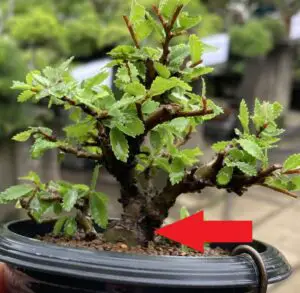
Wiring scar
Wiring can damage your bonsai trees if improperly done. While it is a valuable technique for shaping bonsai trees, it is essential to be aware of the potential risks and take necessary precautions to minimize harm and damage.
Improper wiring practices can lead to detrimental effects on the health and aesthetics of your bonsai tree.
Here are some of the potential harms and damages of bonsai wiring.
Broken branches
One of the risks associated with wiring bonsai trees is the possibility of breaking the branches or scratching the bark. Using unsuited gauge wire or applying it out of season may result in putting too much pressure on the tree or putting the wrong kind of force on a fragile branch.
This is a huge problem because breaking a branch may compel you to make a significant change in styling your tree. Wounds on the bark can create entry points for pathogens, insects or pests, increasing the risk of infections or infestations.
Wire scarring
Left-on wires cause wire scarring on the branches and trunk of the bonsai. If the wire is not removed at the proper time, tree bark is injured to the underlining tissue at first and forms a callus to heal. Then, the tree bark starts to grow around the wire, incorporating the wire inside the tree.
By the time this happened, removing the wire may not return the bark to the former state as the callus tissue that has formed will remain in place. It becomes less visible in time, which may be good enough, but depending on the species, it may be more visible and quite disturbing to the beauty of the trees.
Constricted growth (or death)
If wires are too tight or you made a really hard bent, it can restrict the natural growth of your trees. This constriction can impede the flow of nutrients and water, leading to weakened branches, stunted growth, and even branch dieback. In extreme cases, the whole tree may die because of the bad wiring.
Care must be taken to adjust or remove wires before they begin to cut into the bark or restrict the tree’s growth.
Mitigating Potential Harm of Wiring
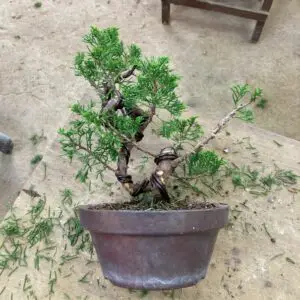
Juniper bonsai styling using aluminum wire
To safeguard the health and well-being of your bonsai tree while employing wiring techniques, it is important to take measures to mitigate potential harm and damage. By following these guidelines, you can mitigate and avoid the damage of bonsai wiring.
Wiring in the right season
Wiring in the right season is crucial to avoid potential damage to your bonsai trees. If done in the wrong season, branches or trunks may wither or break at the bend.
The appropriate time for wiring depends on the species. Wiring coniferous trees (except for some species such as Japanese cedars and needle junipers) can be less stressful if done in fall and winter before new sprouts in spring.
On the other hand, the best time to wire deciduous trees is during the growing season from June to July, as the recovery is quick which minimizes the stress on the trees.
Wire only on healthy trees
Wiring should be applied only to healthy trees. Wiring puts a lot of stress on the bonsai trees and wiring on unhealthy trees will weaken the tree even more. A healthy bonsai is better equipped to recover from the stress of wiring and is less susceptible to potential damage.
Maintain overall tree health through proper care. Give them abundant fertilizer to make them healthy and in full vigor beforehand. Also, avoid wiring trees that are recently repotted. Wait for a while before applying the wire.
Adjust wire tension
Make sure that the wires are not overly tight as this can constrict the growth and compromise the health of your bonsai. It should be tight enough to effectively bend the tree but wrapping too tightly will harm your tree really soon before it can hold the shape.
When you are not experienced, you tend to apply the wire too tightly and damage the tree. The correct way is to encircle the wire gently along the tree rather than wrapping it tightly around.
Traditionally in Japan, it is said that “wrapping with a paper-thin gap” is the ideal bonsai wiring. This slight gap between the wire and the tree is the allowance for growth until the wire is removed. I know this sounds difficult but you can do it as you experience.
Use protective padding
To prevent the wire from biting into the bark, use protective paddings such as raffia between the wire and the branch/trunk. Old and thick branches or trunks are more susceptible to breaking or scarring with wiring. Trees may need protection when you do the hard bent.
This cushioning layer helps distribute pressure and reduces the risk of wire scarring.
Regular monitoring
Regular monitoring is the key to avoiding wire damage. Keep a close eye on the wired areas of your bonsai trees. Regularly inspect the branches and trunk to check for any signs of wire cutting into the bark or causing undue pressure.
It may be only a month from applying the wire when you notice the signs of wiring damage if the trees are growing vigorously.
Timely wire removal
It is crucial to remove the wire once the desired shape is set. Leaving wires on for too long can result in wire scarring or constricted growth. When you notice the wire is biting the tree, remove it anyway even if the shape is not set yet.



